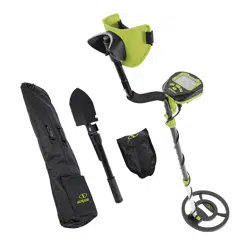Loading ...
Loading ...
Loading ...

14
NOTE: The search coil and the bottom portion of the
pole assembly can be fully submerged in water. However,
never expose the control panel, battery and the cable
plug to water. The weatherproong feature on this metal
detector was designed to allow hunting in inclement
weather but not for prolonged submersion in water.
5. Upon detecting a metallic object, the control panel will
display an arrow under the corresponding target-ID and
emit an audible tone. The depth indicator will also display
the relative depth of the target.
NOTE: If the detector does not detect anything, make
sure that the DISC mode and sensitivity is set correctly for
the intended type of metal. Also make sure that you are
moving the search coil correctly.
6. Once the detector has detected a buried target, continue
sweeping the search coil over the target in a narrowing
range. Make a mental note of the exact spot on the
ground where the detector beeps.
7. Enter pinpoint mode as instructed before. Then move the
search coil over that spot in a front and back and side
to side motion a couple of times to hone in on the exact
location and depth of the object (Fig. 22).
8. Use the included folding shovel to dig up the object. While
digging, use the pinpoint searching mode of the detector
to periodically estimate the depth and position of the
target. Repeat this until the target is found.
Maintenance
mWARNING! To avoid damage, always turn the metal
detector o and remove battery pack from the battery
compartment before cleaning or performing any maintenance.
mWARNING! When servicing, use only identical
replacement parts. Use of any other parts may cause product
damage. To ensure safety and reliability, all repairs should be
performed by a qualied service technician.
General Maintenance
Avoid using solvents when cleaning plastic parts. Most plastics
are susceptible to damage from various types of commercial
solvents and may be damaged by their use.
mWARNING! Do not at any time allow brake uids,
gasoline, petroleum-based products, penetrating oils, etc., to
come into contact with plastic parts. Chemicals can damage,
weaken or destroy plastic parts, which may result in personal
injury.
• Handle the detector gently and carefully. Dropping it can
damage circuit boards and can cause the detector to
malfunction.
• Use the detector only in non-extreme environments.
Temperature extremes can shorten the life of electronic
devices and batteries.
• Wipe the detector with a damp cloth occasionally to keep
it clean. Do not use harsh chemicals, cleaning solvents, or
strong detergents to clean the detector.
• Keep the detector away from dust and droppo, which can
cause premature wear of parts.
Storage
1. Turn o the metal detector and remove the battery pack.
Wipe clean with a damp cloth.
2. Use the included pouch and storage bag to store the
metal detector and all accessories.
3. Store the device indoors in a dry, well-ventilated area. Do
not store the device on or adjacent to fertilizers, gasoline,
or other chemicals.
Disposal
Recycling + Disposal
Always dispose of your battery pack according to federal,
state, and local regulations. Contact a recycling agency in your
area for recycling locations.
• Do not dispose of electrical appliances as unsorted
municipal waste. Use separate collection facilities.
• Contact your local government agency for information
regarding the collection systems available.
• If electrical appliances are disposed of in landlls or
dumps, hazardous substances can leach into the
groundwater and get into the food chain, damaging your
health and well-being.
The product comes in a package that protects it against
damage during shipping. Keep the package until you are
sure that all parts have been delivered and the product is
functioning properly. Recycle the package afterwards or keep it
for long-term storage.
WEEE symbol. Waste electrical products should not
be disposed of with household waste. Please recycle
where facilities exist. Check with your local authority
or local store for recycling regulations.
Fig. 22
Loading ...
Loading ...
Loading ...
